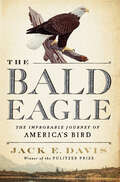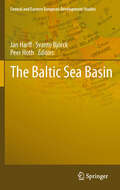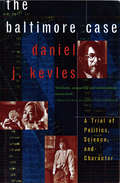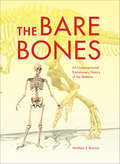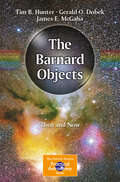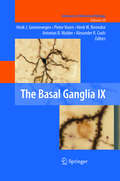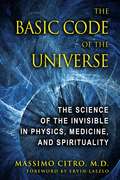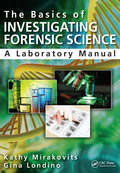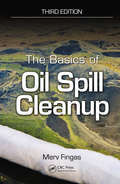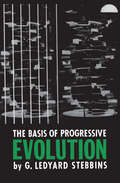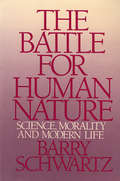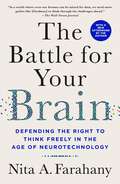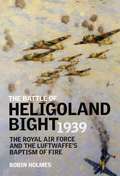- Table View
- List View
The Bald Eagle: The Improbable Journey of America's Bird
by Jack E. DavisBest Books of the Month: Wall Street Journal, Kirkus Reviews From the Pulitzer Prize–winning author of The Gulf, a sweeping cultural and natural history of the bald eagle in America. The bald eagle is regal but fearless, a bird you’re not inclined to argue with. For centuries, Americans have celebrated it as “majestic” and “noble,” yet savaged the living bird behind their national symbol as a malicious predator of livestock and, falsely, a snatcher of babies. Taking us from before the nation’s founding through inconceivable resurgences of this enduring all-American species, Jack E. Davis contrasts the age when native peoples lived beside it peacefully with that when others, whether through hunting bounties or DDT pesticides, twice pushed Haliaeetus leucocephalus to the brink of extinction. Filled with spectacular stories of Founding Fathers, rapacious hunters, heroic bird rescuers, and the lives of bald eagles themselves—monogamous creatures, considered among the animal world’s finest parents—The Bald Eagle is a much-awaited cultural and natural history that demonstrates how this bird’s wondrous journey may provide inspiration today, as we grapple with environmental peril on a larger scale.
The Baltic Sea Basin
by Jan Harff Peer Hoth Svante BjörckThis book reports about the results of a Special Symposium "The Baltic Sea Basin", held on August 11, 2008, within the frame of the 33rd IGC at Oslo, Norway in order to foster the understanding of the Baltic Basin as a unit in terms of genesis, structure, ongoing processes and utilization. It is the first time that in a joint publication, scientists from different disciplines give a comprehensive overview about the Baltic Sea basin in such a general sense. The book will be used not only by students and scientist but also by engineers and decision makers from industry and politics. Summarizing the state of the art in the investigation of the Baltic Sea Basin, but also in the resource utilisation of the basin the book will enhance the development of new monitoring strategies and technical device design including satellite observation methods, the establishment of international research laboratories, innovative topics for interdisciplinary research projects, etc.
The Baltimore Case: A Trial of Politics, Science, and Character
by Daniel J. Kevles"You read with a rising sense of despair and outrage, and you finish it as if awakening from a nightmare only Kafka could have conceived."--Christopher Lehmann-Haupt, New York Times David Baltimore won the Nobel Prize in medicine in 1975. Known as a wunderkind in the field of immunology, he rose quickly through the ranks of the scientific community to become the president of the distinguished Rockefeller University. Less than a year and a half later, Baltimore resigned from his presidency, citing the personal toll of fighting a long battle over an allegedly fraudulent paper he had collaborated on in 1986 while at MIT. From the beginning, the Baltimore case provided a moveable feast for those eager to hold science more accountable to the public that subsidizes its research. Did Baltimore stonewall a legitimate government inquiry? Or was he the victim of witch hunters? The Baltimore Case tells the complete story of this complex affair, reminding us how important the issues of government oversight and scientific integrity have become in a culture in which increasingly complicated technology widens the divide between scientists and society.
The Bar Code Rebellion (The Bar Code #2)
by Suzanne WeynThe second book in the action-packed Bar Code series.They want your identity. They want your freedom. They can't have them. The bar code rebellion.Kayla has resisted getting the bar code tattoo, even though it's mean forfeiting a "normal" life. Without the tattoo, she's an exile. But she can't stay an exile for long. . . .For reasons she doesn't completely understand--but will soon discover--Kayla is at the center of a lethal conspiracy that will soon threaten the very notion of freedom. Kayla can either give in to the bar code, or she can join the resistance and fight it. The choice, for her, is clear: It's time to fight.They want your identity.They want your freedom.They can't have them.The bar code rebellion.
The Bar Code Tattoo (The Bar Code #1)
by Suzanne WeynIndividuality vs. conformity. Identity vs. access. Freedom vs. control.The bar code tattoo.The bar code tattoo. Everybody's getting it. It will make your life easier, they say. It will hook you in. It will become your identity. But what if you say no? What if you don't want to become a code? For Kayla, this one choice changes everything. She becomes an outcast in her high school. Dangerous things happen to her family. There's no option but to run . . . for her life.Indivuality vs. conformity.. Identity vs. access. Freedom vs. control.The bar code tattoo.
The Barcelona School of Ecological Economics and Political Ecology: A Companion in Honour of Joan Martinez-Alier (Studies in Ecological Economics #8)
by Roldan Muradian Sergio Villamayor-TomasIn this open access book, ecological economics and political ecology traditions converge into a single academic school. The book constitutes a common ground where multiple and critical voices are expressed, covering a broad scope of urgent matters at the crossroad between society, economy and the natural environment. The manuscripts composing this compendium offer appealing material for both experienced and younger researchers interested in interdisciplinary exchanges in the field of the social environmental sciences. It combines historical accounts with recent theoretical and empirical developments revolving around the interaction between three foundational notions of the Barcelona School: social metabolism, environmental justice and self-reflective science.
The Bare Bones: An Unconventional Evolutionary History of the Skeleton (Life of the Past)
by Matthew F. Bonnan“Bonnan combines wit and passion with the sensibilities of a talented instructor in this encyclopedic tour of the vertebrate skeleton.” —Publishers WeeklyWhat can we learn about the evolution of jaws from a pair of scissors? How does the flight of a tennis ball help explain how fish overcome drag? What do a spacesuit and a chicken egg have in common? Highlighting the fascinating twists and turns of evolution across more than 540 million years, paleobiologist Matthew Bonnan uses everyday objects to explain the emergence and adaptation of the vertebrate skeleton. What can camera lenses tell us about the eyes of marine reptiles? How does understanding what prevents a coffee mug from spilling help us understand the posture of dinosaurs? The answers to these and other intriguing questions illustrate how scientists have pieced together the history of vertebrates from their bare bones. With its engaging and informative text, plus more than 200 illustrative diagrams created by the author, The Bare Bones is an unconventional and reader-friendly introduction to the skeleton as an evolving machine.“No bones about it, a text like The Bare Bones was sorely needed in the popular literature of vertebrate paleontology. Matthew Bonnan’s tome on the evolution, form, and function of the vertebrate skeleton may seem daunting in size, but it is written in an enjoyable and readable fashion that will absolutely delight all sorts of readers from expert to soon-to-be-expert.” —Palaeontologia Electronica“A remarkably fun book to read . . . his conversational style and wit make this an unintimidating yet highly informative book that would work wonderfully in college courses.” —The Quarterly Review of Biology
The Barley Genome (Compendium of Plant Genomes)
by Gary J. Muehlbauer Nils SteinThis book presents an overview of the state-of-the-art in barley genome analysis, covering all aspects of sequencing the genome and translating this important information into new knowledge in basic and applied crop plant biology and new tools for research and crop improvement. Unlimited access to a high-quality reference sequence is removing one of the major constraints in basic and applied research. This book summarizes the advanced knowledge of the composition of the barley genome, its genes and the much larger non-coding part of the genome, and how this information facilitates studying the specific characteristics of barley.One of the oldest domesticated crops, barley is the small grain cereal species that is best adapted to the highest altitudes and latitudes, and it exhibits the greatest tolerance to most abiotic stresses. With comprehensive access to the genome sequence, barley’s importance as a genetic model in comparative studies on crop species like wheat, rye, oats and even rice is likely to increase.
The Barnard Objects: Then and Now (The Patrick Moore Practical Astronomy Series)
by Tim B. Hunter Gerald O. Dobek James E. McGahaThe Barnard Objects have fascinated professional and amateur astronomers for over one hundred years. Many of those objects first imaged by E.E. Barnard on black-and-white photographic plates are now being captured daily in thousands of color astrophotographs. This book tells of Barnard’s story; describing his life and work as well as how the fields of astronomy and astrophotography have transformed ever since.The chapters in this book are equal parts history and science. It will provide readers with an introduction to nebula science and the incredible discoveries made in this field over the decades; including an overview of popular astronomical catalogues and a detailed look at how astronomical imaging has advanced since Barnard’s time, from early plates to digital imaging and chips. In addition, the book features a comprehensive guide to viewing and imaging these objects yourself. A glossary of astronomical and photographic terms is provided, along with detailed references. And, an updated table displaying the locations of these Barnard Objects; including the missing twenty-five objects from E.E. Barnard’s original catalogue.Richly researched and illustrated, this fascinating reference will attract astronomers of all skill levels interested in astrophotography and how it has changed over the past hundred years.
The Basal Ganglia IX
by Antonius B. Mulder Pieter Voorn Hendrik Jan Groenewegen Henk W. Berendse Alexander R. CoolsThe aim of the International Basal Ganglia Society (IBAGS) is to further our understanding of normal basal ganglia function and the pathophysiology of disorders of the basal ganglia, including Parkinson's disease, Huntington's disease, and schizophrenia. Each triennial meeting of IBAGS brings together basic research scientists from all disciplines as well as clinicians who are actively involved in the treatment of basal ganglia disorders, to discuss the most recent advances in the field and to generate new approaches and ideas for the future. This volume comprises the proceedings of the 9th meeting of IBAGS, held in Egmond aan Zee, The Netherlands, September 2nd-6th, 2007.
The Basalt Fiber—Material Design Art (SpringerBriefs in Applied Sciences and Technology)
by Marco ManciniThis book presents a design research on the basalt fiber, a natural mineral material with important characteristics, and investigates the material's properties, production techniques, and most common uses, while also delving into aspects yet to be improved. The work presents a part of original research in between art and design, in which concepts, prototypes, and ideas are proposed, aimed at the enhancement of basalt fiber also from an esthetic point of view and not only from a performance one. By working on its perceived qualities and creative and formal potential, it is possible to support and extend the use of this material in many areas of design, including product, exhibit, cultural industries, and fashion. Considering that environmental regulations are increasingly stringent, the use of basalt fiber may in some cases be more advantageous than other popular technical fibers, both because of its own performance characteristics and specifically because of its inherent sustainability.
The Baseline Concept in Biodiversity Conservation: Being Nostalgic or Not in the Anthropocene Era
by Laurent Godet Simon Dufour Anne-Julia RolletThe Anthropocene era has been marked by such significant human pressure that it has led to the sixth mass extinction. The Baseline Concept in Biodiversity Conservation interprets human domination of the Earth as the process of gradual landscape change, the execution of which is neither linear nor homogeneous. This book is structured around three key questions: Where and when did everything go wrong? How do we define baseline states for biodiversity conservation strategies? How are reference states mobilized in a concrete way through case studies? Today, biodiversity conservation faces a dilemma that this book sheds light on: return to states less modified by humans than today but in a world that has changed significantly; or, let the nature of tomorrow express itself where it still can but without a road map.
The Basic Code of the Universe: The Science of the Invisible in Physics, Medicine, and Spirituality
by Ervin Laszlo Massimo CitroExplains the universal information code connecting every person, plant, animal, and mineral and its applications in science, health care, and cosmic unity • Examines research on consciousness, quantum physics, animal and plant intelligence, emotional fields, Kirlian photography, and the effects of thoughts, emotions, and music on water • Reveals the connections between the work of Ervin Laszlo on the Akashic field, Rupert Sheldrake on morphogenetic fields, Richard Gerber on vibrational medicine, and Masaru Emoto on the memory of water DNA dictates the physical features of an organism. But what dictates how something grows--from the division of cells in a human being to the fractal patterns of a crystal? Massimo Citro reveals that behind the complex world of Nature lies a basic code, a universal information field--also known as the Akashic field, which records all that was, is, and will be--that directs not only physical development and behavior but also energetic communication and interactions among all living and non-living things. The author examines research on consciousness, quantum physics, animal and plant intelligence, the power of intention, emotional fields, Kirlian photography, and the effects of thoughts, emotions, and music on water. Linking the work of Ervin Laszlo on the Akashic field, Rupert Sheldrake on morphogenetic fields, Richard Gerber on vibrational medicine, and Masaru Emoto on the memory of water, Citro shows how the universal information field connects every person, plant, animal, and mineral--a concept long known by shamans and expounded by perennial wisdom. Putting this science of the invisible to practical use, he explains his revolutionary system of vibrational medicine, known as TFF, which uses the information field to obtain the benefits of natural substances and medications in their “pure” informational form, offering side-effect-free remedies for health and well-being.
The Basics of Investigating Forensic Science: A Laboratory Manual
by Kathy Mirakovits Gina LondinoOnce confined to four-year colleges and graduate schools, forensic science classes can now be found in local high schools as well as in two-year community colleges. The Basics of Investigating Forensic Science: A Laboratory Manual is designed for the beginning forensic science student and for instructors who wish to provide a solid foundation in ba
The Basics of Molecular Biology
by Alexander VologodskiiAccessible and comprehensive, this book describes the universal cellular nature of living organisms and is an indispensable tool for anyone in the sciences who wishes to get a quick overview of molecular biology. Individual chapters cover nucleic acids and proteins, genetic code and protein synthesis, the fidelity of transferring genetic information to the next generations, and the regulation of various processes inside the cells. Special attention is paid to new areas rising from modern DNA sequencing technologies which transform biology. The book also touches on developing areas, such as cures for cancer and CRISPR, which are important for medicine and the future of humankind.
The Basics of Nuclear and Particle Physics (Undergraduate Texts in Physics)
by Alexander Belyaev Douglas RossThis undergraduate textbook breaks down the basics of Nuclear Structure and modern Particle Physics. Based on a comprehensive set of course notes, it covers all the introductory material and latest research developments required by third- and fourth-year physics students. The textbook is divided into two parts. Part I deals with Nuclear Structure, while Part II delves into Particle Physics. Each section contains the most recent science in the field, including experimental data and research on the properties of the top quark and Higgs boson. Detailed mathematical derivations are provided where necessary to helps students grasp the physics at a deeper level. Many of these have been conveniently placed in the Appendices and can be omitted if desired. Each chapter ends with a brief summary and includes a number of practice problems, the answers to which are also provided.
The Basics of Oil Spill Cleanup
by Merv FingasReflecting the rapid progress in cleanup technology since the previous edition, this revised and expanded third edition of The Basics of Oil Spill Cleanup covers current cleanup techniques, how oil spills are measured and detected, and the properties of the oil and its long-term fate in the environment. It also deals with why, how often, and where
The Basis of Progressive Evolution
by G. Ledyard StebbinsIn this incisive book, a distinguished geneticist has succeeded in relating the extraordinary biological discoveries of the last two decades to the basic questions about the origin and evolution of life on earth. The "molecular revolution" in biology--culminating in the discovery of the relations of the giant molecules of living matter--the operation of the genetic code, and the relational order in the biological world are all considered.Originally published in 1969.A UNC Press Enduring Edition -- UNC Press Enduring Editions use the latest in digital technology to make available again books from our distinguished backlist that were previously out of print. These editions are published unaltered from the original, and are presented in affordable paperback formats, bringing readers both historical and cultural value.
The Bastard Brigade: The True Story of the Renegade Scientists and Spies Who Sabotaged the Nazi Atomic Bomb
by Sam KeanFrom New York Times bestselling author Sam Kean comes the gripping, untold story of a renegade group of scientists and spies determined to keep Adolf Hitler from obtaining the ultimate prize: a nuclear bombScientists have always kept secrets. But rarely have the secrets been as vital as they were during World War II. In the middle of building an atomic bomb, the leaders of the Manhattan Project were alarmed to learn that Nazi Germany was far outpacing the Allies in nuclear weapons research. Hitler, with just a few pounds of uranium, would have the capability to reverse the entire D-Day operation and conquer Europe. So they assembled a rough and motley crew of geniuses - dubbed the Alsos Mission - and sent them careening into Axis territory to spy on, sabotage, and even assassinate members of Nazi Germany's feared Uranium Club. The details of the mission rival the finest spy thriller, but what makes this story sing is the incredible cast of characters-both heroes and rogues alike-including: Moe Berg the major league catcher who abandoned the game for a career as a multilingual international spy; the strangest fellow to ever play professional baseball.Werner Heisenberg the Nobel Prize-winning physicist credited as the discoverer of quantum mechanics; a key contributor to the Nazi's atomic bomb project and the primary target of the Alsos mission. Colonel Boris Pash a high school science teacher and veteran of the Russian Revolution who fled the Sovit Union with a deep disdain for Communists and who later led the Alsos mission. Joe Kennedy Jr. the charismatic, thrill-seeking older brother of JFK whose need for adventure led him to volunteer for the most dangerous missions the Navy had to offer. Samuel Goudsmit a washed-up physics prodigy who spent his life huntinh Nazi scientist-and his parents, who had been swept into a concentration camp-across the globe. Irène and Frederic Joliot-Curie a physics Nobel-Prize winning power couple who used their unassuming status as scientists to become active members of the resistance. Thrust into the dark world of international espionage, these scientists and soldiers played a vital and largely untold role in turning back one of the darkest tides in human history.
The Bat Scientists
by Mary Kay CarsonDr. Merlin Tuttle and his colleagues at Bat Conservation International aren't scared of bats. These bat crusaders are fascinated by them, with good reason. Bats fly the night skies in nearly every part of the world, but they are the least studied of all mammals. As the major predator of night-flying insects, bats eat many pests. Unfortunately bats are facing many problems, including a terrifying new disease. White-nose Syndrome is infecting and killing millions of hibernating bats in North America. But Dr. Tuttle, with the help of his fellow bat scientists are in the trenches-and caves-on the front line of the fight to save their beloved bats.
The Battery: How Portable Power Sparked a Technological Revolution
by Henry SchlesingerIn the tradition of Mark Kurlansky's Cod and David Bodanis's E=MC2, The Battery is the first popular history of the technology that harnessed electricity and powered the greatest scientific and technological advances of our time.What began as a long-running dispute in biology, involving a dead frog's twitching leg, a scalpel, and a metal plate, would become an invention that transformed the history of the world: the battery. From Alessandro Volta's first copper-and-zinc model in 1800 to twenty-first-century technological breakthroughs, science journalist Henry Schlesinger traces the history of this essential power source and demonstrates its impact on our lives.Volta's first battery not only settled the frog's leg question, it also unleashed a field of scientific research that led to the discovery of new elements and new inventions, from Samuel Morse's telegraph to Alexander Graham Bell's telephone to Thomas Edison's incandescent lightbulb. And recent advances like nanotechnology are poised to create a new generation of paradigm-shifting energy sources.Schlesinger introduces the charlatans and geniuses, paupers and magnates, attracted to the power of the battery, including Michael Faraday, Guglielmo Marconi, Gaylord Wilshire, and Hugo Gernsback, the publisher and would-be inventor who coined the term "science fiction." A kaleidoscopic tour of an ingenious invention that helped usher in the modern world, The Battery is as entertaining as it is enlightening.
The Battle Book of Ypres: A Reference to Military Operations in the Ypres Salient 1914–1918
by Beatrix BriceOf the many hard-fought battles on the Western Front, Ypres stands out as an example of almost inhuman endeavour. For four long years it was the focal point of desperate fighting. Officially there were four main battles in 1914, 1915, 1917 and 1918; these were more accurately peaks in a continuing struggle, for Ypres symbolised Belgian defiance, and the British continued to expend disproportionate resources on defending it. It never fell, although the Germans came close to its gates, and indeed its loss would have been a severe blow to morale.The Battle Book of Ypres, originally published in 1927 and now presented again as a special Centenary Edition, comprises a chronological account of the fighting in the Ypres Salient during the First World War, followed by a useful and unique alphabetical reference to the events in and around each hamlet, village or wood names familiar to those who fought or followed the course of war all those years ago, names now once again lost in insignificance. The names given to each stage of the struggle by the Battle Nomenclature Committee are listed in the appendix. Also included is an index of formations and units, an annotated bibliography and a new Foreword by military historian Nigel Cave.
The Battle for Human Nature: Science, Morality and Modern Life
by Barry Schwartz"Provocative and richly textured. . . .Schwartz's analyses of the inadequacies of contemporary scientific views of human nature are compelling, but the consequences are even more worthy of note." --Los Angeles Times Out of the investigations and speculations of contemporary science, a challenging view of human behavior and society has emerged and gained strength. It is a view that equates "human nature" utterly and unalterably with the pursuit of self-interest. Influenced by this view, people increasingly appeal to natural imperatives, instead of moral ones, to explain and justify their actions and those of others.
The Battle for Your Brain: Defending the Right to Think Freely in the Age of Neurotechnology
by Nita A. FarahanyA new dawn of brain tracking and hacking is coming. Will you be prepared for what comes next?Imagine a world where your brain can be interrogated to learn your political beliefs, your thoughts can be used as evidence of a crime, and your own feelings can be held against you. A world where people who suffer from epilepsy receive alerts moments before a seizure, and the average person can peer into their own mind to eliminate painful memories or cure addictions.Neuroscience has already made all of this possible today, and neurotechnology will soon become the “universal controller” for all of our interactions with technology. This can benefit humanity immensely, but without safeguards, it can seriously threaten our fundamental human rights to privacy, freedom of thought, and self-determination.From one of the world’s foremost experts on the ethics of neuroscience, The Battle for Your Brain offers a path forward to navigate the complex legal and ethical dilemmas that will fundamentally impact our freedom to understand, shape, and define ourselves.
The Battle of Heligoland Bight 1939: The Royal Air Force and the Luftwaffe's Baptism of Fire
by Robin HolmesThis illustrated history chronicles the first British bombing raid of WWII and the early lessons learned about strategic bombing. On the 4th of September 1939, Squadron Leader Paul Harris led 149 Squadron to Brunsbüttel, Wilhelmshaven in a Vickers Wellington Mk. 1 medium bomber. On the way he ordered that the guns of his airplane be tested, only to make the horrifying discovery that not one of them worked. Though he was flying completely defenseless, he chose to press on. On the 18th of December, Harris flew to Wilhelmshaven once again and took part in the Battle of Heligoland Bight, the first major encounter between the Royal Air Force and the Luftwaffe. This time he flew a Wellington Mk.1A—codenamed &“R&” for Robert—and his guns were red hot and ready. Of all the Wellington bombers that fought the Luftwaffe, Paul Harris&’ old Wimpy is the only one left, preserved at the Brooklands Museum in Weybridge, England.
